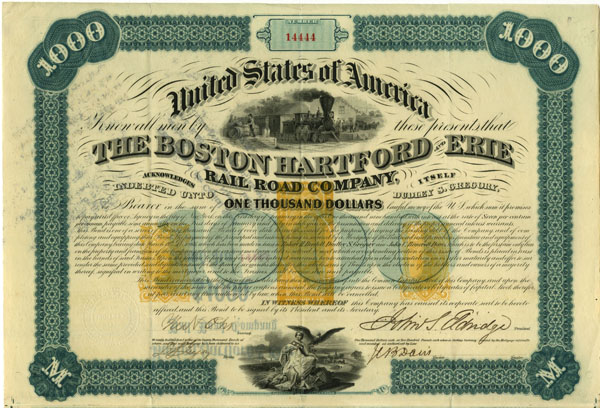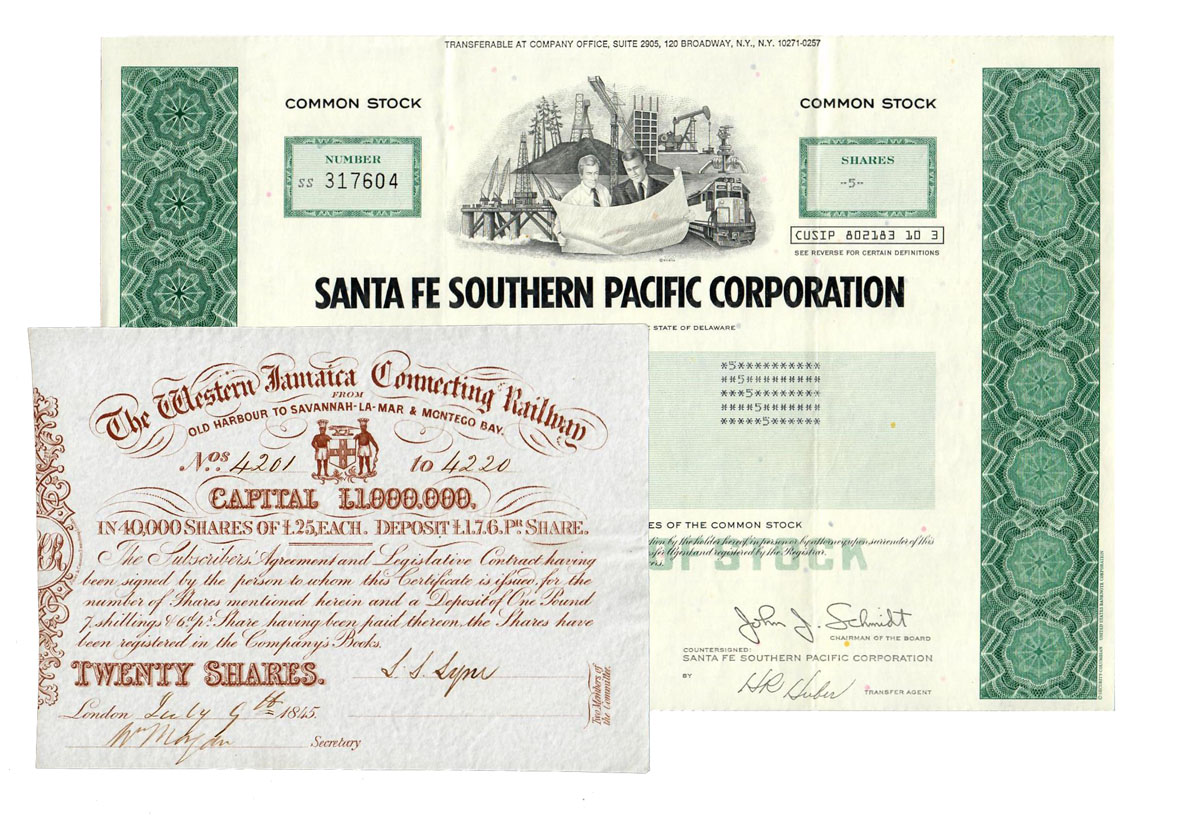
Excess yellow in certificate images
Excess yellow is the most common problem I see is otherwise acceptable images

In a normal year, I catalog between 7,000 and 9,000 images. The majority of those images have a yellow tint. Some are downright awful.
Causations
Results are similar, but I believe excess yellow in scripophily images results from as many as four sources:
- certificates themselves
- the majority of papers used to print certificates seem to have an ivory or slight yellow coloration
- thin paper
- source light
- photographing certificates under incandescent lights
- photographing certificates with insufficient light
- photographing certificates in rooms lit by early morning or late afternoon sun
- scanning certificates against reflective white backgrounds
- sun exposure
- aged paper, particularly pulp paper used for many generic certificates
- scanners
- uncalibrated scanners
- aged scanner bulbs

How "yellow" are certificates to start with?
Not necessarily a lot, although they all appear whiter to our eyes than they really are. To confirm, select a few of your "whitest" certificates and compare them against each other. Select the whitest of them all and compare them against "bright white" office copy paper. I think you'll see that almost all are more "ivory" or gray than you initially thought.
Can we eliminate yellowed images?
It is not going to be possible to eliminate all yellowed images because so many certificates have a natural light yellow tint. So first, start protecting them from turning more yellow and getting "sunburned" by keeping them away from ultraviolet light.
- Keep certificates away from sunlight. This is especially recommended for generic certificates printed on pulp paper.
- Avoid framing genuine certificates. Instead, use scanned and printed copies.
And if needing to photograph...
- Be aware of time of day. Photograph certificates around mid-day if using a camera anywhere near sunlit windows.
- Be aware of colors of artificial light. Incandescent lights are reddish and fluorescent lights impart greenish tints. LEDs are generally whiter, but can be "warmer" or "cooler." Assume that all lights are imparting some color of their own.
- Use a flash if photographing certificates in conditions of insufficient light. In fact, adding flash under otherwise ordinary lights can "clean up" the color spectrum somewhat.
Then...
- Remove or diminish yellowish tints with photo editing software.
What is your intended use?
- Personal records? Image quality and odd tints may not matter.
- Appraisals for insurance or tax purposes? Quality might matter, depending on the pickiness of your insurer and the size of any potential settlement. You might need appraisals that pre-date an insurable loss of your collection. You may be required to send images as proof of your collection to someone who may never have seen certificates in person. The IRS will almost certainly require appraisals when taking deductions for donations to historical societies and museums. My guess is higher quality images with good colors are not going to matter much, but why take the chance?
- Inspections prior to selling through auction houses? Major houses are going to want to see your certificates or at least good images before committing to sell your material. I assume collectors would want to present their holdings in the best possible manner.
- Sales on eBay? Yes, it is true that sellers can sell anything on eBay if the price is right. But that does NOT mean sellers will achieve the highest possible bids by using junk images. I know that many sellers are satisfied with whatever bids they receive. They may not know that I am the guy who records prices every day and I am the guy who KNOWS that the majority of amateur sellers are "leaving money on the table." Small and terrible images might sell, but good images should almost always sell better.
Why are scanned images often yellow?
Now we are getting down to the nitty gritty. You will notice I did not say one of the remedies was to buy a scanner. Scanners are great at reproducing accurately-scaled and highly-detailed images, BUT they don't always do a great job reproducing 100% accurate colors from certificates.
It turns out that stocks, bonds and related documents present scanners with a yellow witch's brew created by two innocent-seeming qualities:
- many certificates are thin
- many certificates have a slight yellowish tint
Here is an illustration of three scans created within 90 seconds of each other on an HP477 Color LaserJet Pro scanner with the exact same settings. The scanner bulb had been used for fewer than 300 scans. At left is a 4-page George H. LaBarre catalog printed on very white paper. The image in the center is an untouched scan of a certificate just as it was saved by the scanner. The image on the right is the same certificate scanned with a piece of light gray posterboard placed between the certificate and the scanner cover.
By comparison to LaBarre's catalog, the yellow in the certificate in the center is quite obvious and unappealing. The same certificate on the right shows some yellow but looks much more realistic. Here's what happened.
- The scanner bulb emitted neutral white light, neither yellow nor blue.
- The light hit the certificate.
- Most of the light bounced off, modified by whatever colors were on the surface of the certificate.
- That light was measured by the sensor in the scanner.
- Some of the light penetrated the certificate and picked up some of the paper's natural color.
- That modified light hit the cover of the scanner and bounced back toward the certificate.
- On the way back, some light went through the paper again and picked up still more natural color.
- The light that had penetrated the paper twice was measured by the sensor.
Depending on the scanner, either the scanner bulb moves or the paper moves. By comparison to the speed of light, any such movement is immaterial, so any yellow in the certificate is added to whatever yellow is on the certificate. The thicker the paper, the more natural the resulting color measurement should be. The thinner the paper, the greater the addition of any color in the certificate. Whether the paper is made of cotton fibers or wood fibers, their natural vegetative colors are likely to be in the yellow or brownish parts of the spectrum. Unless the fibers were heavily bleached before manufacture, it seems reasonable that yellow parts of the spectrum should exist in the paper of many if not most certificates.
These examples and many others prove that:
- we will definitely encounter problems scanning thin certificates
- we can diminish some of those problems by limiting reflectance off scanner covers.
How thin is thin?
A certificate is thin enough to cause yellowing problems if we can easily see text on the back or from another document placed underneath. Show-through from the back is quite evident in the stock certificates shown above.
The Penn Central stock certificate below is sufficiently thick to avoid problems even though the paper has a slight ivory tint and there is text on the back. When compared to George's catalog, only the barest hint of yellow is visible, but it is no more obvious in the scan than on the certificate itself.
The easiest remedy
Awareness is the first step in preventing yellow from appearing in scanned or photographed images of certificates. With that in mind:
- Use adequate light when photographing certificates.
- Place a piece of light gray, very light blue. or black posterboard between certificates and scanner covers when scanning. (See more hints in my section on show-through and yellowing.)
- Replace scanner bulbs (if possible) when scanners begin imparting their own colors or dark bands.
Awareness and attempts at prevention cannot keep all unwanted colors and problems out of images of certificates. Photo editing software, however, can correct many problems after the fact. To that end, I have prepared several tutorials focused strictly on modifying images of certificates. See links to all tutorials at Image manipulation.